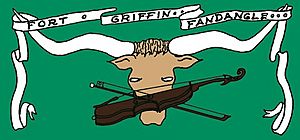Fort Griffin Fandangle facts for kids
Quick facts for kids Fort Griffin Fandangle |
|
|---|---|

Fandangle Logo
|
|
| Music | Robert Nail Alice Reynolds James Ball Louann George Elsa Turner Bill Overton |
| Lyrics | Robert Nail Alice Reynolds James Ball Louann George Elsa Turner Bill Overton |
| Productions | 1938-1940 Albany, Texas 1947-1957 Albany, Texas 1964 Canyon, Texas 1965-present Albany, Texas |
The Fort Griffin Fandangle is the oldest outdoor musical in Texas. This exciting show takes place at The Prairie Theatre, an outdoor stage in Albany, Texas.
Created by Robert Nail in 1938, the Fandangle now has over 400 performers. It celebrates the history of Fort Griffin and the town of Albany. More than 10,000 people watch the show every year. You can see it on Thursday, Friday, and Saturday evenings during the last two weeks of June.
Contents
What's the Story?
The Fort Griffin Fandangle tells the story of how the area around Fort Griffin and Albany, Texas grew. Fort Griffin was a military outpost from 1867 to 1881. It helped protect early settlers in Shackelford County, Texas.
The story is told by two old-timers, a cattleman and his wife. They sit on a ranch porch and share memories of the past. The show is made up of different parts. Each part shares a historical event through songs and dances.
How the Fandangle Began
The Fandangle started with a play called Dr. Shackelford’s Paradise. This play was written and directed by Robert Edward Nail Jr. from Albany. He worked with local music teacher Alice Reynolds.
Dr. Shackelford’s Paradise was an outdoor musical. It showed the history of Shackelford County. The play was so popular that adults joined the cast. That summer, it became the Fort Griffin Fandangle. The Fandangle Association was officially formed in 1947.
Robert Nail set three important rules for the show. First, anyone with family ties to Shackelford County could be in it. Second, the show would only be advertised by word of mouth. Third, there would be no bad language in the show.
Alice Reynolds helped a lot from the very beginning. She wrote songs and designed the sets. She also created the famous steer-head and fiddle emblem for the Fandangle. For many years, she played the organ during performances.
The name Fandangle was chosen because it sounded good. Fandangle is a local version of the Spanish word "fandango," which means a fast dance. At first, only traditional folk music and dances were used. But over time, new songs and dances were added. This practice continues today. Each year's show is a little different, even though some parts are repeated.
Important Moments in Fandangle History
The Fandangle stopped during World War II. Robert Nail and many other performers were serving in the military. The show returned in 1947 and ran until 1957.
After a break, the Fandangle was performed again in 1964. It was brought to Canyon, Texas, to open a new outdoor theater. In 1979, the Texas Legislature named the Fort Griffin Fandangle one of the official state plays of Texas.
Many people have helped the Fandangle grow. James Ball, Elsa Turner, and Luann George wrote songs. Luann George took over as organist in 1983. Marge Bray was the choreographer for a long time. She became the director after James Ball, who directed for four years after Robert Nail passed away in 1968.
G. P. Crutchfield, an engineer, also made big contributions. He built a real-looking Butterfield stagecoach. He also created a machine that looked like the Texas Central Railroad train. He even built a blacksmith shop on wheels. With Cecil R. Dye, he built a steam calliope, which still plays before shows. These creations and many other groups appear in the annual parade. The parade happens on Thursday afternoon of the second week of performances.
Early shows were held at the local football stadium. In 1965, The Prairie Theatre was built west of town. The land was leased for just one dollar a year. All full-scale shows have been held there ever since.
Shorter versions of the Fandangle have been performed in many places. These "samplers" are usually performed in the spring. They help prepare for the main show in late May and early June. These samplers were performed in Europe in 1967 and 1976. They were also performed in Washington, D.C. in 1984.
After Marge Bray passed away in 1994, Betsy Black Parsons became the director. In 2008, the Fort Griffin Fandangle celebrated its 70th anniversary. That same year, Albany celebrated its 150th birthday. A sampler show was performed at the LBJ Ranch that year. By then, the Fandangle had grown to over 400 cast and crew members.
What People Say
The Dallas Morning News describes the Fandangle as "as professional as a multi-million dollar Broadway musical, with sets and costumes to match." The Abilene Reporter-News calls the program "Frontier history served up with genuine earthiness, spiced by rare humor."

